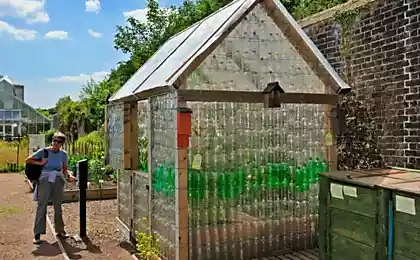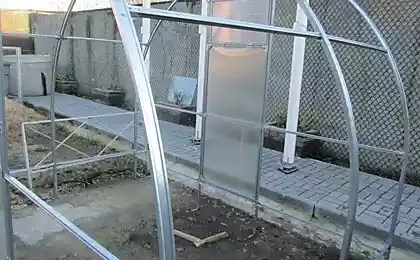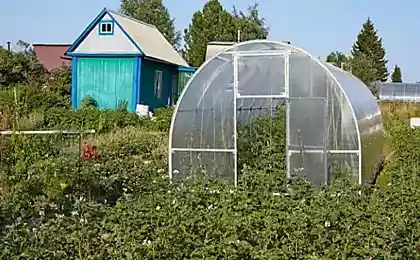744
How to make solar heating for greenhouses with their hands
Surely now no one is surprised, seeing even in the winter, the stores, markets a variety of vegetables, fruits, berries. Tomatoes, cucumbers, apples, pears, strawberries, cherries, melons, a variety of exotic fruits – you name it. Dazzled by this beauty, from all this abundance. But beauty is beauty, but the quality of all of this, the environmental purity of products is often questionable. Like it was grown than fertilized, protected against pests – these questions most often, the answer to impossible.
So now you can see that every day increases the number of those who independently grow a variety of plants in his summer cottage. And grows year-round, providing your family with fresh organic vegetables and fruits. And when the bountiful harvest of the surplus they go on sale, bringing a certain income.
Of course, in the open air to grow year round fruits and vegetables impossible. For this constructed greenhouses. Greenhouses are used only seasonally, usually in early spring, when preparing the seedling to protect it from frost and bad weather. The greenhouse is also operated all year round, so to create favourable conditions for the cultivation of plants care must be taken to ensure it is heating.
Heating greenhouses can be organized in different ways. It is possible to heat the greenhouse with electricity using heaters, infrared lamps, electric cable, laid in the drainage of the floor of the greenhouse. This is a rather expensive method. In addition to the cost of the equipment will need to pay for the electricity consumed for heating.
You can organize water heating installing in the greenhouse radiators, paving or drainage pipes that will circulate the heated water. It is possible to heat a greenhouse with hot air. And it is possible to build a combined system of heating of greenhouses, and to combine different ways so that the impact was maximum, and costs are minimal.

Laying of pipes for water heating in the floor of the greenhouse
From the point of view of energy consumption the most economical is to organize the heating of greenhouses using solar energy. Moreover, regardless of the heating method chosen, the air, water or combined. Because the sun's energy costs nothing, but some coolant will be heated by a solar collector, has absolutely no value.
Greenhouse heating solar air collectora collector is the main element of the heating system. Depending on the location of this manifold heating can either be performed by natural circulation of air in the system, or by using fans.
In the first case, the outlet manifold should be located below the funnel inlet in the greenhouse. Then the air heated in the collector, according to the laws of convection will rise up through the duct and into the greenhouse. Replacing the cooled air back to the duct enters the collector, is heated and returned to the greenhouse. This cycle is continuous, solar light lasts all day.
In the second case, the location of the solar collector does not matter, because air circulation is supported by fans installed in the greenhouse at the entrance of warm air. This method ensures an even distribution of warm air masses around the heated volume, and, very importantly, uniform heating of the soil.
Naturally, the ducts (especially the hot) should be covered with insulation so that the air could not quickly cool down. In the night the greenhouse air without hot can recharge fast enough to cool. Therefore, to maintain the thermal regime necessary to provide backup heating circuit. It could be heaters, radiators.
Air solar collector is a very simple design. Collect it yourself from scrap materials is possible in less than an hour. It's a sealed wooden box with a height of 10 – 15 cm. the Bottom is made of fiberboard. For the strength side walls are connected to wooden bars with a cross section of 5x5 cm.
On the bottom of the stacked insulator – foam or mineral wool. On top of the insulating layer is placed the absorber, for example, galvanized sheet iron. To enlarge the heating area, this sheet can attach additional ribs.
All the internal seams of the box are carefully processed "Sealant", then the box inside is covered with black heat-resistant paint. Depending on where and how you will install the manifold in its sidewall, embedded pipes for spuskanija and deflation. After all the preparatory work, the box closed with a hot glass joints glass housing sealed with a "Sealant".

Scheme of the solar air collector
It remains to put the manifold into place and connect the air ducts to the greenhouse. Wherein the outlet manifold should be placed above the pipe input. The header sizes are determined only by the dimensions of the sheet metal and glass. Depending on the size of the greenhouse, such collectors may be several.
The air in this manifold is heated to a temperature of 45°C – 50°C. the Heated air is not only maintained in the greenhouse comfortable for plant temperature, but, giving up its heat, still heats the ground, which creates the most favorable conditions for the development of the root system of plants.
Water solar collectors for heating of greenhousesFor a number of reasons-water heating of greenhouses is more preferable, although the cost of such a system is much higher than the cost of air heating systems. In essence, the system of solar water heating greenhouse does not differ from the solar heating system of the home country.
The only differences are the form and arrangement of the heating elements. In greenhouses instead of the usual room heating radiators along the walls of the laid pipes in which warm water circulates. Pipes are also laid in the earthen floor of the greenhouse at a depth of 30 to 50 cm is thereby ensured in a greenhouse and heating the air and heating the soil.

Schematic diagram solar water heating
In a hot water heating system, the heat carrier can be heated in flat-plate collectors and collectors on the vacuum tubes. In a flat manifold to the absorber is attached a flat coil, which needs a copper tube. This copper tube is initially filled with the salt, and only after that it can be bent without the occurrence of creases.
When the handset will take shape, salt is easily washed away from it with running water. The coil is attached to the absorber and used black heat-resistant paint. Input and output connections are brought out, and the holes through which they were sealed.

Scheme of flat solar collector
Other designs are collectors, constructed using vacuum tubes whose tips are connected with the pipe of the cooling circuit. Vacuum tubes are glass cylinder, inside which is placed a copper tube with a low-boiling liquid. The upper end of the copper tube is slightly expanded and sealed.
From the space between the outer and the outer tube air is pumped out to create the greatest possible thermal insulation. The liquid inside the copper pipe under the influence of solar radiation heats and evaporates. The vapor rises to the tip and heats it. Giving heat, steam cools, condenseries on the walls and drips down. The tip temperature can reach 270°C – 300°C.

Scheme of the vacuum tube

Vacuum manifold
Heated in solar collectors, the fluid circulation pumps is supplied to the heat exchanger installed in the boiler. The heated boiler water enters the heating system. This tank needs to have powerful thermal insulation to retain heat in the dark.
To the water in the boiler is not over-cooled, provides another heating element backup heating. This system is activated if necessary in the dark and can be powered by batteries, solar power at home.
Solar energy keeps becoming a part of our everyday life. Possibility is inexhaustible. The sun gives us light, heat, electricity. And not to take advantage of this free source of energy would be simply unforgivable. published
Source: solarb.ru/kak-sdelat-solnechnoe-otoplenie-dlya-teplitsy
So now you can see that every day increases the number of those who independently grow a variety of plants in his summer cottage. And grows year-round, providing your family with fresh organic vegetables and fruits. And when the bountiful harvest of the surplus they go on sale, bringing a certain income.
Of course, in the open air to grow year round fruits and vegetables impossible. For this constructed greenhouses. Greenhouses are used only seasonally, usually in early spring, when preparing the seedling to protect it from frost and bad weather. The greenhouse is also operated all year round, so to create favourable conditions for the cultivation of plants care must be taken to ensure it is heating.
Heating greenhouses can be organized in different ways. It is possible to heat the greenhouse with electricity using heaters, infrared lamps, electric cable, laid in the drainage of the floor of the greenhouse. This is a rather expensive method. In addition to the cost of the equipment will need to pay for the electricity consumed for heating.
You can organize water heating installing in the greenhouse radiators, paving or drainage pipes that will circulate the heated water. It is possible to heat a greenhouse with hot air. And it is possible to build a combined system of heating of greenhouses, and to combine different ways so that the impact was maximum, and costs are minimal.

Laying of pipes for water heating in the floor of the greenhouse
From the point of view of energy consumption the most economical is to organize the heating of greenhouses using solar energy. Moreover, regardless of the heating method chosen, the air, water or combined. Because the sun's energy costs nothing, but some coolant will be heated by a solar collector, has absolutely no value.
Greenhouse heating solar air collectora collector is the main element of the heating system. Depending on the location of this manifold heating can either be performed by natural circulation of air in the system, or by using fans.
In the first case, the outlet manifold should be located below the funnel inlet in the greenhouse. Then the air heated in the collector, according to the laws of convection will rise up through the duct and into the greenhouse. Replacing the cooled air back to the duct enters the collector, is heated and returned to the greenhouse. This cycle is continuous, solar light lasts all day.
In the second case, the location of the solar collector does not matter, because air circulation is supported by fans installed in the greenhouse at the entrance of warm air. This method ensures an even distribution of warm air masses around the heated volume, and, very importantly, uniform heating of the soil.
Naturally, the ducts (especially the hot) should be covered with insulation so that the air could not quickly cool down. In the night the greenhouse air without hot can recharge fast enough to cool. Therefore, to maintain the thermal regime necessary to provide backup heating circuit. It could be heaters, radiators.
Air solar collector is a very simple design. Collect it yourself from scrap materials is possible in less than an hour. It's a sealed wooden box with a height of 10 – 15 cm. the Bottom is made of fiberboard. For the strength side walls are connected to wooden bars with a cross section of 5x5 cm.
On the bottom of the stacked insulator – foam or mineral wool. On top of the insulating layer is placed the absorber, for example, galvanized sheet iron. To enlarge the heating area, this sheet can attach additional ribs.
All the internal seams of the box are carefully processed "Sealant", then the box inside is covered with black heat-resistant paint. Depending on where and how you will install the manifold in its sidewall, embedded pipes for spuskanija and deflation. After all the preparatory work, the box closed with a hot glass joints glass housing sealed with a "Sealant".

Scheme of the solar air collector
It remains to put the manifold into place and connect the air ducts to the greenhouse. Wherein the outlet manifold should be placed above the pipe input. The header sizes are determined only by the dimensions of the sheet metal and glass. Depending on the size of the greenhouse, such collectors may be several.
The air in this manifold is heated to a temperature of 45°C – 50°C. the Heated air is not only maintained in the greenhouse comfortable for plant temperature, but, giving up its heat, still heats the ground, which creates the most favorable conditions for the development of the root system of plants.
Water solar collectors for heating of greenhousesFor a number of reasons-water heating of greenhouses is more preferable, although the cost of such a system is much higher than the cost of air heating systems. In essence, the system of solar water heating greenhouse does not differ from the solar heating system of the home country.
The only differences are the form and arrangement of the heating elements. In greenhouses instead of the usual room heating radiators along the walls of the laid pipes in which warm water circulates. Pipes are also laid in the earthen floor of the greenhouse at a depth of 30 to 50 cm is thereby ensured in a greenhouse and heating the air and heating the soil.

Schematic diagram solar water heating
In a hot water heating system, the heat carrier can be heated in flat-plate collectors and collectors on the vacuum tubes. In a flat manifold to the absorber is attached a flat coil, which needs a copper tube. This copper tube is initially filled with the salt, and only after that it can be bent without the occurrence of creases.
When the handset will take shape, salt is easily washed away from it with running water. The coil is attached to the absorber and used black heat-resistant paint. Input and output connections are brought out, and the holes through which they were sealed.

Scheme of flat solar collector
Other designs are collectors, constructed using vacuum tubes whose tips are connected with the pipe of the cooling circuit. Vacuum tubes are glass cylinder, inside which is placed a copper tube with a low-boiling liquid. The upper end of the copper tube is slightly expanded and sealed.
From the space between the outer and the outer tube air is pumped out to create the greatest possible thermal insulation. The liquid inside the copper pipe under the influence of solar radiation heats and evaporates. The vapor rises to the tip and heats it. Giving heat, steam cools, condenseries on the walls and drips down. The tip temperature can reach 270°C – 300°C.

Scheme of the vacuum tube

Vacuum manifold
Heated in solar collectors, the fluid circulation pumps is supplied to the heat exchanger installed in the boiler. The heated boiler water enters the heating system. This tank needs to have powerful thermal insulation to retain heat in the dark.
To the water in the boiler is not over-cooled, provides another heating element backup heating. This system is activated if necessary in the dark and can be powered by batteries, solar power at home.
Solar energy keeps becoming a part of our everyday life. Possibility is inexhaustible. The sun gives us light, heat, electricity. And not to take advantage of this free source of energy would be simply unforgivable. published
Source: solarb.ru/kak-sdelat-solnechnoe-otoplenie-dlya-teplitsy
Firm Future Faraday introduced the 1050-strong electrocreaser
Where you can buy a great shirt at a great price? - advises maikasoft.com.ua























